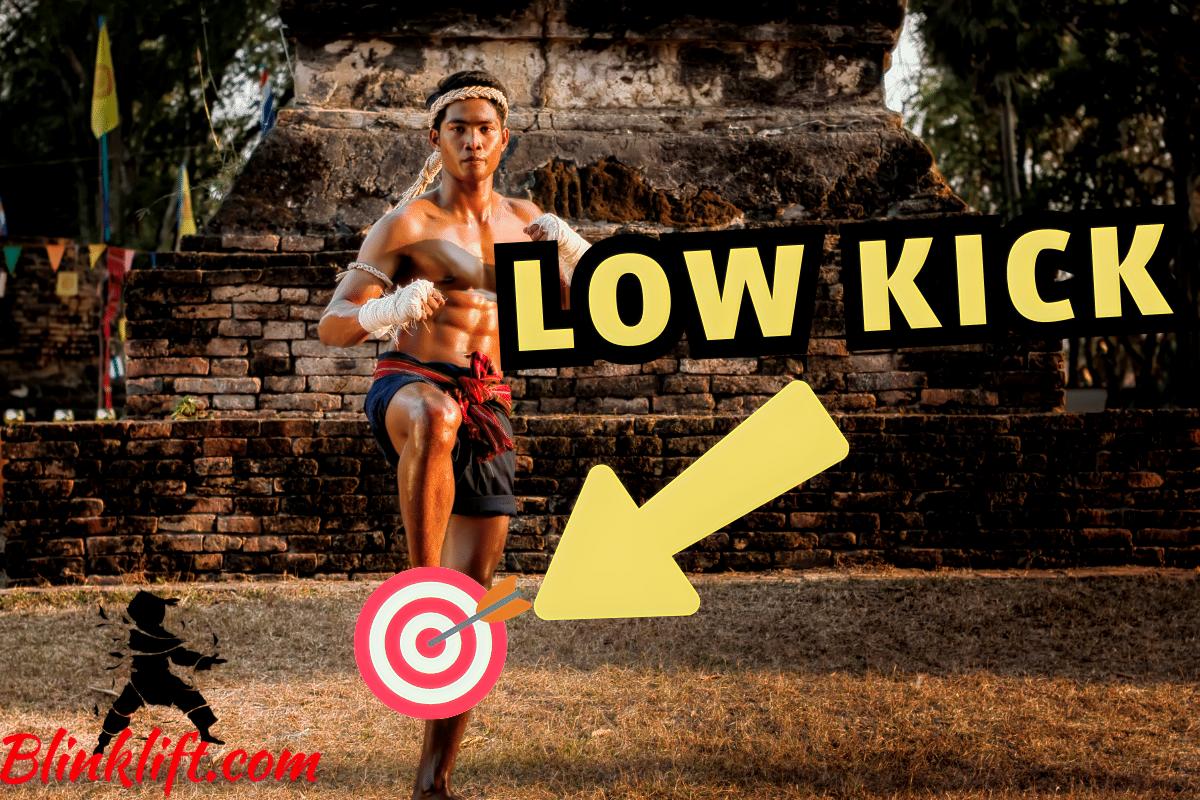The Low Kick in Muay Thai is one of the most effective, influential, and popular kicks. If you want to call yourself a fighter of any kind, you must at least know to perform it on a basic level. And frankly, it’s not as difficult to do if you’re learning from a proper source.
This is why I’ve decided to write this article. I constantly see the same mistakes with Muay Thai and MMA disciples who execute the Low Kick. The mistakes I see are what stopping them from skyrocketing their kicking abilities. Not only that, but the mistakes I see repeat themselves in all kicks; but more on that later.
The low kick in Muay Thai is a technique that involves striking the lower part of your opponent’s leg with the shin. It is one of the fundamental techniques in Muay Thai and is highly effective for disrupting your opponent’s balance, mobility, and causing damage.
What we’ll cover in this article is how to execute the Low Kick flawlessly. After you finish reading it, you’ll be able to start practicing it the right way, which will differentiate you from most Muay Thai fighters.
We’ll also review combinations with the Low Kick in Muay Thai and some of its variations. You can skip through these parts of the article by following the links.
Anyways, let’s now dive into the most important of the article: how to execute the Low Kick effectively!
How to Low Kick in Muay Thai
Let’s now review how you can use the Low Kick effectively in Muay Thai. This is the most important part of the article, so pay close attention.
What we’ll do is break down the execution into 6 steps. That way, you’ll be able to follow along and break down your technique, which will improve your muscle memory and allow you to build muscle memory much quicker.
Thus, the way I formatted this part is purposeful. I want you to follow along and implement each step to ensure you’re performing it correctly.
Let’s dive into the first one!
#1 – Stance
The first step, believe it or not, has nothing to do with the kick. Instead, the first step commences in your fighting stance. That’s why you must work on it to ensure you’re capable of throwing any kick out there and causing some real damage.
But it’s not only important for causing a lot of damage, it’s also useful for the after-effect, where you want to recoil your leg and defend yourself. I’m jumping too far ahead in the future, more on defense later.
Start in your Muay Thai fighting stance, with your feet shoulder-width apart, knees slightly bent, and hands up to protect your face.
If you want to perfect your fighting stance in Muay Thai (in easy steps), you can follow the link to learn how to do that easily and effectively.

#2 – Chambering
Chambering is done with any kick in Muay Thai. Your goal is likely to generate more power and cause more damage. That makes a lot of sense. In that case, as if you’re charging a special attack in a video game, you want to almost charge your leg by lifting your kicking leg and slightly bending it at the knee.
Lift your rear leg, bending at the knee, while keeping your foot flexed and your shin parallel to the ground. This position allows you to generate power for the kick.
#3 – Pivot
The next point we’ll review is using your body to generate more power. This is key to (1) generating more force, and (2) ensuring your Low Kick is quick and effective.
Rotate your hips and pivot on your lead foot, turning your body slightly sideways. This movement adds rotational force and power to the kick.
I’m confident this is the primary mistake Muay Thai fighters make with kicking. You know what? Using your hips and defending after the kick (more on that in step #6) are the two primary mistakes.
You want to be purposeful about training the Low Kick. You must put your body into it if you want to generate a substantial amount of force. If you’ve ever seen a fierce Low Kick being thrown in Muay Thai ever, you’ll see that the fighter puts his body into it. You want to do the same.
Remember, rotate your hips and pivot your lead foot, turning your body sideways. This movement should be quick and purposeful.
#4 – Striking Surface
The next step after you lift your rear leg and turn your hips and body sideways is to hit the target. However, what you don’t want to get wrong is with which body part you hit your opponent. As you can remember, we’re learning to execute the Low Kick effectively.
Thus, if you think about it, the best part of the leg we want to hit with is the shin! It’s one of the most painful parts of the leg you can use to cause substantial damage.
The shin is the primary striking surface for the low kick in Muay Thai. The aim is to strike your opponent’s leg with the lower part of your shin bone, just above the foot. The contact should be made with the area between your shin and the muscle on the outer side of your lower leg.
#5 – Execution
And now, we’re off to the fun part. Remember, lift your rear leg, rotate your hips and body sideways, and extend your leg so that your shin hits the opponent’s leg. One of the best targets you can aim at is the opponent’s quad, where the tendon and the muscle meet (the lowest part of the quad.)
Extend your leg and drive your shin forward, aiming to strike the target area on your opponent’s leg. Generate power by using your hip rotation, transferring the force from your leg and core into the kick.

#6 – Recoil and Defense
And now, for the last step in the sequence, we have recoil and defense. Once you throw your Low Kick properly, which means using your hips, lifting your rear foot beforehand, and selecting your target, you’ll be able to hit the opponent with great damage.
However, it doesn’t end there. You must continue with the execution by ensuring you’re as invulnerable as possible. When you throw any kick, you won’t be in an optimal position. In fact, let’s say you miss the kick, your opponent will find it extremely easy to counter your kick, which places you at a disadvantage.
We want to solve that issue.
After landing the kick, quickly retract your leg back to the starting position, ready to defend or follow up with additional strikes.
This is key to proper execution. In fact, many Muay Thai fighters skip this step and aren’t seeing as many results as they can since their opponents are able to get back at them. Therefore, make sure to recall your leg to your fighting stance and continue fighting. You might want to continue throwing strikes, which will ensure your opponent is defensive.
You now know how to throw a ferocious and effective Low Kick. Let’s now dive into the second part of the article: combinations!
Low Kick Combinations (Muay Thai)
Combinations in fighting are what differentiate good and excellent fighters. The same applies to Muay Thai, which is home to many offensive combinations that can knock out an opponent single-handedly, especially an untrained opponent.
So you want to become familiar with combinations, which we’ll cover in this part. You should already be quite familiar with how to execute a fierce Low Kick. That’s fantastic. Now, we want to begin combining more techniques with it, so to cause more damage and do so more quickly.
Here are the best combinations in Muay Thai that involve the Low Kick!
- Jab-Low Kick:
- Start with a quick jab to set up the distance.
- Follow up immediately with a Low Kick targeting your opponent’s lead leg or rear leg.
- Cross-Low Kick:
- Throw a powerful cross with your rear hand.
- Transition smoothly into a Low Kick with your rear leg, targeting the same side of your opponent’s leg as your cross.
- Hook-Low Kick:
- Throw a hook punch with your lead hand, aiming for your opponent’s head or body.
- Swiftly transition into a Low Kick using your rear leg, targeting the inside or outside of your opponent’s leg.
- Teep-Low Kick:
- Utilize a front teep kick to create distance and disrupt your opponent.
- Immediately follow up with a Low Kick to capitalize on the space created, aiming for your opponent’s leg.
- Fake Roundhouse-Low Kick:
- Begin with a fake roundhouse kick to distract your opponent and draw their attention away from their legs.
- Instead of completing the roundhouse kick, swiftly switch to a Low Kick, catching your opponent off guard.
Low Kick Variations
This is going to be the 3rd, and final, section of this article. What we discussed thus far should be enough for you to get into the gym and start practicing. However, once you begin to feel comfortable with the low kick, which won’t be long, you want to start learning more variations.
In Muay Thai, there are several Low Kick variations that you can incorporate into your arsenal. These variations allow you to target different areas of your opponent’s leg and adapt to various situations. Here are some common Low Kick variations in Muay Thai:
- Inside Low Kick:
- Aim to strike the inside of your opponent’s lead leg or rear leg, targeting the quadriceps or the knee area.
- This variation can be effective for disrupting your opponent’s balance and weakening their lead leg.
- Outside Low Kick:
- Target the outside of your opponent’s lead leg or rear leg, focusing on the outer thigh or the knee area.
- This variation can be used to slow down your opponent’s movement and reduce their mobility.
- Slashing Low Kick:
- Instead of a direct strike, perform a diagonal or slashing motion with your shin across your opponent’s leg.
- This technique can cause additional damage by “slicing” through the muscles and creating a cutting effect.
- Step-Up Low Kick:
- Take a small step forward or to the side before executing the Low Kick.
- This variation allows you to generate additional power and reach your opponent’s leg from a different angle.
- Sweep Low Kick:
- Instead of striking with full force, focus on sweeping your opponent’s leg out from under them.
- This technique is often used as a defensive move to off-balance your opponent and create an opportunity to counter-attack.
- Double Low Kick:
- Perform two consecutive Low Kicks, targeting the same leg or alternating between the inside and outside of your opponent’s leg.
- This combination can overwhelm your opponent’s defense and increase the chances of landing a solid strike.
Final Words
The Low Kick is one of the most effective techniques in many kicking-based martial arts, such as Kickboxing, Taekwondo, and Muay Thai. You’ll be able to use it to cause a lot of damage and inflict tons of physical pain on your opponent.
Your next step is to practice, practice, and repeat. There’s no learning without actual experience. So get to the gym and start implementing what you had learned in this article. Good luck!
The Low Kick is one of the most effective kicks in Muay Thai. However, there are so many more effective ones that you want to learn. So if you want to learn to perform all the basic kicks in Muay Thai, follow this link!
Here are other articles you’d enjoy reading:

